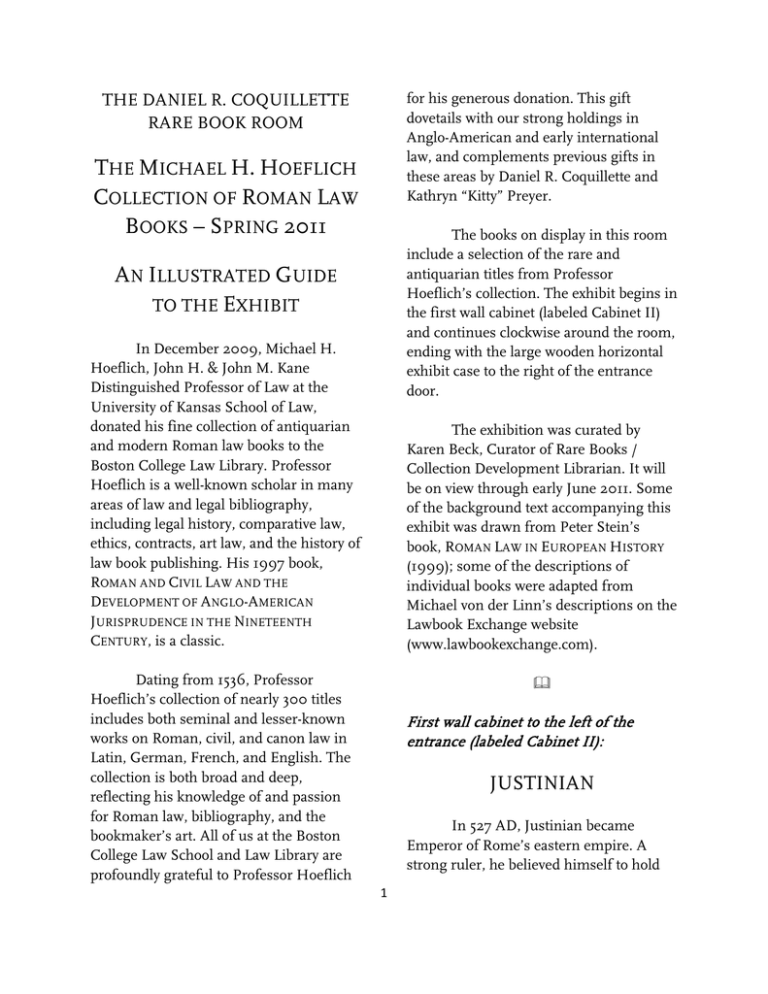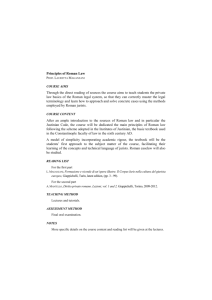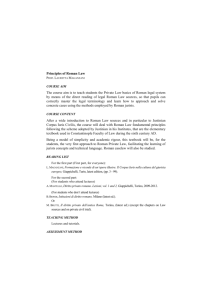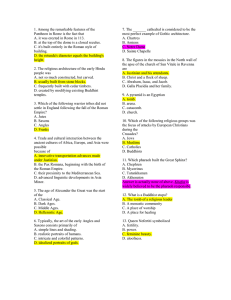THE DANIEL R. COQUILLETTE RARE BOOK ROOM
advertisement

for his generous donation. This gift dovetails with our strong holdings in Anglo-American and early international law, and complements previous gifts in these areas by Daniel R. Coquillette and Kathryn “Kitty” Preyer. THE DANIEL R. COQUILLETTE RARE BOOK ROOM THE MICHAEL H. HOEFLICH COLLECTION OF ROMAN LAW BOOKS – SPRING 2011 The books on display in this room include a selection of the rare and antiquarian titles from Professor Hoeflich’s collection. The exhibit begins in the first wall cabinet (labeled Cabinet II) and continues clockwise around the room, ending with the large wooden horizontal exhibit case to the right of the entrance door. AN ILLUSTRATED GUIDE TO THE EXHIBIT In December 2009, Michael H. Hoeflich, John H. & John M. Kane Distinguished Professor of Law at the University of Kansas School of Law, donated his fine collection of antiquarian and modern Roman law books to the Boston College Law Library. Professor Hoeflich is a well-known scholar in many areas of law and legal bibliography, including legal history, comparative law, ethics, contracts, art law, and the history of law book publishing. His 1997 book, ROMAN AND CIVIL LAW AND THE DEVELOPMENT OF ANGLO-AMERICAN JURISPRUDENCE IN THE NINETEENTH CENTURY, is a classic. The exhibition was curated by Karen Beck, Curator of Rare Books / Collection Development Librarian. It will be on view through early June 2011. Some of the background text accompanying this exhibit was drawn from Peter Stein’s book, ROMAN LAW IN EUROPEAN HISTORY (1999); some of the descriptions of individual books were adapted from Michael von der Linn’s descriptions on the Lawbook Exchange website (www.lawbookexchange.com). Dating from 1536, Professor Hoeflich’s collection of nearly 300 titles includes both seminal and lesser-known works on Roman, civil, and canon law in Latin, German, French, and English. The collection is both broad and deep, reflecting his knowledge of and passion for Roman law, bibliography, and the bookmaker’s art. All of us at the Boston College Law School and Law Library are profoundly grateful to Professor Hoeflich First wall cabinet to the left of the entrance (labeled Cabinet II): JUSTINIAN In 527 AD, Justinian became Emperor of Rome’s eastern empire. A strong ruler, he believed himself to hold 1 supreme religious and temporal power. The famous church of Hagia Sophia was the symbol of his religious authority. One of the symbols of his temporal authority was a quartet of legal works produced at his direction which collectively came to be known as the CORPUS IURIS CIVILIS. Most of what we know about ancient Roman law is based on these texts. authorized to make substantive changes to ensure that the Digest expressed the law of sixth-century Byzantium. Called interpolations, these changes have been a source of scholarly interest for the past several centuries. Scholars have labored to determine which bits of the text were original to the classical jurists and which were sixth-century alterations to make the law relevant to the Byzantium of Justinian’s time. Justinian directed his minister Tribonian and an army of legal scholars to comb through Roman legal sources dating back 1,000 years, from about 500 BC. From this careful review of early sources, they compiled a CODE which arranged imperial constitutions, or legislation written by Roman Emperors, in chronological order. During this process the scholars tried to rid the text of redundancies, complexities, and contradictions. The Code was divided into titles and spanned twelve books. A third prong of Justinian’s massive overhaul of Roman law was the INSTITUTES, an elementary textbook for students that was nonetheless seen as equally authoritative as the DIGEST and CODE. The DIGEST and INSTITUTES became law in 533 and the CODE a year later. These three pieces comprised Justinian’s compilation. He made the whole work his own (rather than attributing it to earlier emperors and jurists) by converting it into statutory form. He forbade any reference to the original source materials and tried to ban commentaries on his text, stating that it was crystal clear as it was. Justinian continued to issue constitutions, or NOVELS, until his death in AD 565. The Novels were collected and added to the other three parts and the whole compilation came to be called the CORPUS IURIS CIVILIS, the body of the civil law. This massive work marked the culmination of 1,000 years of legal development. Without Justinian’s compilation we would know little about A second work, the DIGEST, was an anthology of extracts from the writings of great early Roman jurists. Each fragment was attributed to its original source. According to Justinian, the immense volume represented only one-twentieth of the material with which its compilers began, and it required three years to complete. The Digest is arranged by title (i.e. subject); and the titles are arranged in a total of fifty books. As with the Code, Justinian instructed the compilers to omit redundancies and eliminate contradictions, so evidence of disagreement among the classical jurists was erased. Finally, the compilers were 2 earlier Roman law, as little classical law has survived directly. Even before Justinian’s time, popes and emperors jockeyed for power. In the late fifth century, the Church argued for the right to try cases affecting it. At the same time, the Church was developing its own legal system based on resolutions of Church councils, the Bible, and papal decisions, known as decretals. These sources were melded into a conceptual whole based on Roman secular – or civil – laws. This case features three attractive examples of Justinian’s famous work. IMP. CAES. IUSTINIANI th INSTITUTIONUM LIBRI IIII. 4 ed. Lyon, 1587 (shown closed). LES INSTITUTS DE L’EMPEREUR JUSTINIEN. 2d ed. Paris, 1669. In the centuries after Justinian the canon and civil bodies of law continued to evolve, waxing and waning in influence as popes and emperors vied for power. Both bodies of law were subjects of academic study as well. However, for a long while canon law was at a disadvantage because it lacked an authoritative body of texts akin to Justinian’s CORPUS JURIS CIVILIS. This changed in the mid-twelfth century, when the monk Gratian published his DECRETUM, mining sources including the Bible, decretals, and fragments of Roman law much as Justinian had done with Roman law texts centuries earlier. In 1234, about a century after Gratian’s DECRETUM appeared, Pope Gregory IX promulgated a large collection of papal decretals. It was sometimes called the LIBER EXTRA because it was outside (extra) Gratian’s DECRETUM. Together, the DECRETUM and the DECRETALS were intended to form the body of the law of the Church. In 1298, Pope Boniface added the LIBER SEXTUS, which supplemented the LIBER EXTRA. By the end of the fourteenth CORPUS JURIS PORTATILE. Erfurt (Germany), 1730. Cabinet III: CIVIL AND CANON LAW 3 century, the Church had its own CORPUS IURIS CANONICI, a compilation of Church law on the same scale as Justinian’s compilation of civil law, the CORPUS IURIS CIVILIS. ROMAN LAW IN THE 16TH CENTURY During the centuries following Justinian’s rule, his texts – and Roman law in general – were studied and incorporated into the legal systems of different nations. The Roman law revival started in Italy during the middle ages, then was taken up by France, the Netherlands, and then Germany in later centuries. In ROMAN LAW IN EUROPEAN HISTORY, Peter Stein asserts that the texts of ancient Roman law have constituted “a kind of legal supermarket, in which lawyers of different periods have found what they needed at the time.” Arranged in rough chronological order, the materials in the following cabinets expand upon this theme. Though in theory the two systems existed on separate but parallel tracks, in practice the Church assumed jurisdiction over nearly everything that pertained to sin, salvation or damnation, such as crimes, adultery, forgery, homicide, marriage, family law, and even financial matters such as taking and making loans, interest, sales, and debt. By the fourteenth century, the two sets of laws came to be dealt with together, even by civilian lawyers. The phrase “both laws” began to refer to two aspects of what was in many ways regarded as a single legal system, the ius commune, for all of Europe. This cabinet features four examples of the seminal works in the development of canon law. JOHANNES FERRARIUS. IOANNIS FERRARII MONTANI ADNOTATIONES IN IIII. INSTITUTIONUM IUSTINIANI LIBROS. Lyons, 1536. DECRETALES EPISTOLAE SUMMORUM PONTIFICUM A GREGORIO NONO PONTIFICE MAXIMO COLLECTAE. Paris, 1550. This very rare volume is the oldest of Professor Hoeflich’s gift books. Its ornamental title page features the name of the printer, Jacob Giunta. DECRETALES D. GREGORII PAPAE IX. Venice, 1584 (shown closed). SEXTVS LIBER DECRETALIVM. Leiden, 1553. CORPUS JURIS CANONICI. Basel, 1717 (shown closed). Cabinet IV: 4 certain period of time, usually in regard to a property title. JACQUES CUJAS. ... IURIS CIVILIS INTERPRETUM NOSTRI SECULI FACILÈ PRINCIPIS COMMENTARII IN IURIS IUSTINIANÆI LIBROS ELEMENTARES ... COMPREHENSOS. Geneva, 1610. At the birth of the Renaissance in the fifteenth century, scholars studied and revered classical antiquity in all its branches, including law. They regarded Justinian’s DIGEST as a butchered version of the original classical Latin texts upon which it was based. Jacques Cujas (15221590) was a humanist scholar whose encyclopedic knowledge of the CORPUS IURIS CIVILIS enabled him to determine whether the classical Roman jurists to which Justinian’s text was attributed were likely to have written particular fragments. NICHOLAS VIGELIUS. INSTITUTIONUM IURIS PUBLICI, LIBRI III. Basel, 1572 (shown closed). This handsome vellum-bound volume still retains its original leather ties. SEBASTIAN BRANT. TITULORUM OMNIUM IURIS TAM CIUILIS QUAM CANONICI EXPOSITIONES. Leiden, 1581 (shown closed). JOACHIM MYNSINGER VON FRUNDECK. APOTELESMA SIVE CORPUS PERFECTUM SCHOLIORUM AD QUATUOR LIBROS INSTITUTIONUM IURIS CIVILIS. Basel, 1563. Brant (1457-1521) was a legal scholar, a professor of jurisprudence, a humanist, and a poet. He was most famous for his satire DAS NARRENSCHIFF (THE SHIP OF FOOLS). This large volume is opened to the verso of the title page, showing the Mynsinger von Frundeck coat of arms. GIOVANNI FRANCESCO BALBO. TRACTATUS DE PRAESCRIPTIONIBUS. Venice, 1582 (shown closed). Cabinet V: ROMAN LAW IN 17 -CENTURY EUROPE First published in 1511, this work is concerned with the Roman law of prescription, the principle whereby a right or liability is created or extinguished over a TH 5 Roman law was received to a greater or lesser extent in different European countries, depending on the force of their own customary laws, royal legislation, and their own common law legal systems. Very broadly, courts came to apply the civil law, the ius commune, if it was suitable and not contrary to local statutes or customs. Lawyers also cited to civil law texts to assist courts in interpreting the law. The authors and works in these next three cases were instrumental in furthering the study of Roman law, and the development of the civil law, in seventeenth-century Europe. Jacques Godefroy (1587-1652) was a member a French noble family, many of whom had careers as jurists. He studied law and history in France before returning to Geneva to embark on a career of public service. Also a law teacher and a scholar, he wrote many important legal works, including several historical studies of Roman law. IACOBI GOTHOFREDI. NOVUS IN TITULUM PANDECTARUM DE DIVERSIS REGULIS IURIS ANTIQUI, COMMENTARIUS. Geneva, 1653. IACOBO GOTHOFREDO. FONTES QUATUOR IURIS CIUILIS IN UNUM COLLECTI. Geneva, 1653 (shown closed). JACOBI GOTHOFREDI. OPERA JURIDICA MINORA. Leiden, 1733. 6 ARNOLD VINNIUS & OTHERS. DE ORIGINE & PROGRESSU JURIS CIVILIS ROMANI. Leiden, 1671 (shown closed). This vellum-bound volume features the Arnhem crest stamped in gold. Cabinet VI (across the room): ARNOLDI VINNII. TRACTATUS QUINQUE DE PACTIS, JURISDICTIONE, COLLATIONIBUS, TRANSACTIONIBUS, ET QUAESTIONIBUS JURIS SELECTIS. Rhenum, 1722. TH 17 -CENTURY EUROPE, CONT’D Arnold Vinnius (1588-1657) was one of the Netherlands’ leading jurists and law professors. He was most famous for a comprehensive commentary on Justinian’s INSTITUTES which first appeared in 1642 and remained a standard reference until the end of the eighteenth century. Vinnius sought to present Roman civil law as a source of the basic notions of universal law derived from nature, and also as a source of legal practice. Widely acclaimed throughout Europe, Vinnius’ commentary was published in multiple editions in several countries. Two editions, plus other works of his, appear in this case. The title page of this volume features two-color printing and the autograph of a former owner, Franciscus Josephus Mostinck. 7 ORIGINUM JURIS CIVILIS LIBRI TRES. Venice, 1758. Giovanni Vincenzo Gravina (1664– 1718) was an Italian man of letters and a jurist, expert in both the civil and the canon law. This collection of his works includes his most famous: DE ROMANO IMPERIO (completed in 1712) and ORIGINES JURIS CIVILIS (1713). JEAN-VINCENT GRAVINA. ESPRIT DES LOIX ROMAINES. 3 vols. Amsterdam & Paris: 1766. This work is a French translation of his ORIGINUM JURIS CIVILIS LIBRI TRES, rearranged by the translator, M. Requier. Volume 1 begins with the topic, “On the nature of good and evil.” ARNOLDI VINNII. IN QUATUOR LIBROS INSTITUTIONUM IMPERIALIUM COMMENTARIUS ACADEMICUS & FORENSIS. Amsterdam, 1665. JEAN DOMAT. THE CIVIL LAW IN ITS NATURAL ORDER. 2d ed., 2 vols. London, 1727. In the latter seventeenth century, some European legal scholars reexamined and recast their own national laws, and Roman law as well, according to the principles of a universal natural law. Natural law was based not on traditional customary legal practices but on common sense or natural reason which was supposedly shared by all people. These efforts were probably due to a yearning in war-torn Europe for an impartial law that transcended regional differences. Some scholars believed that Roman law might fill that need. In CIVIL LAW IN ITS NATURAL ORDER, Jean Domat (1625-1696), combined the materials of Roman and ARNOLDI VINNII. IN QUATUOR LIBROS INSTITUTIONUM IMPERIALIUM COMMENTARIUS ACADEMICUS, ET FORENSIS. 2 vols. Leiden, 1747. This edition of Vinnius’ famous work was edited about a century after it first appeared by the distinguished jurist Johann Gottlieb Heineccius. Cabinet VII: 17TH-CENTURY EUROPE, CONT’D JANI VINCENTII GRAVINAE. JURISCONSULTI OPERA; SEU, 8 French law into a single system and placed it on a foundation of ethical principles. Domat’s work is considered to be one of the most important works on legal science produced in France. It was also one of the main sources of France’s Napoleonic Code and the German Civil Code. This English translation, by Strahan, is considered an excellent study of Roman law and, thanks to Strahan’s notes, a useful book on comparative law as well. Cabinet VIII: ROMAN LAW TH IN 18 -CENTURY EUROPE Cornelius van Bynkershoek (1673-1743) was a Dutch jurist and legal theorist who wrote important works on Roman law, international law, and the law of the sea. CHRISTIAN WOLFF. JUS GENTIUM METHODO SCIENTIFICA PERTRACTATUM. Halae, 1749. CORNELII VAN BYNKERSHOEK. OBSERVATIONUM JURIS ROMANI LIBRI QUATUOR. Leiden, 1733. Gradually, natural law theory became more and more abstract, as evidenced by this famous work by Christian Wolff (1679-1754). He produced an elaborate mathematical schema of natural law as a series of moral duties, all rationally deduced from general moral principles, that were owed by everyone in society. CORNELII VAN BYNKERSHOEK. OBSERVATIONUM JURIS ROMANI LIBRI QUATUOR. 2d ed. Leiden, 1735. CORNELIS VAN BYNKERSHOEK. QUAESTIONUM JURIS PUBLICI LIBRI DUO. 2d ed. Leiden, 1751. First published in 1737, this treatise considers questions dealing with international law and the customs of war. Many scholars have considered this to be Bynkershoek's greatest work. Cabinet IX: 9 18TH-CENTURY EUROPE, CONT’D incorporating Roman law and French customary law in his analyses. Horizontal wooden cabinet to the left of the entrance door: JOHANN GOTTLIEB HEINECCIUS. ELEMENTA JURIS CIVILIS SECUNDUM th ORDINEM INSTITUTIONUM. 8 ed. Edinburgh, 1780. ROMAN LAW IN ENGLAND AND AMERICA Johann Gottlieb Heineccius (16811741) was a prominent German jurist and a professor of jurisprudence. The leading German scholar of Roman law in his lifetime, he belonged to the school of jurists who attempted to treat law as a rational discipline rather than as an empirical craft based on custom and expediency. He also wrote separate works on modern civil law, German law, and natural law. In Germany these had become distinct systems of law. The reception of Roman law in England was an especially complicated matter. England relied on its own common law for certain disputes, and on civil law for others, such as those brought before the Equity and Admiralty courts. Additionally, England had its own Church courts which applied canon law. Practitioners in the canon and civil law courts belonged to a guild, Doctors’ Commons, which was equivalent to the Inns of Courts for the common lawyers. Though the two guilds battled for turf, the English government looked to the Civilian lawyers of Doctors’ Commons to conduct international negotiations. In his book, ROMAN AND CIVIL LAW AND THE DEVELOPMENT OF ANGLOAMERICAN JURISPRUDENCE IN THE NINETEENTH CENTURY (shown here), Professor Hoeflich examined the writings of Anglo-American legal theorists to show how Roman and civil law influenced the development of Anglo-American common law. The works of some of these writers are represented in this case. ROBERT JOSEPH POTHIER. PANDECTAE JUSTINIANEAE : IN NOVUM ORDINEM DIGESTAE : CUM LEGIBUS CODICIS, ET NOVELLIS, QUAE JUS PANDECTARUM CONFIRMANT, EXPLICANT AUT ABROGANT. 5 vols. Paris, 1818-20. Early in his life, Robert Joseph Pothier (1699-1772) of France set himself the task of reducing both the Roman and the French customary laws to a rational and usable order. He reworked Justinian’s DIGEST, retaining the original titles but reordering the fragments and linking them with additional passages. Published between 1748 and 1752, the work brought him international fame. He later wrote a famous series of treatises on specific subjects, 10 This handsome little volume features a modern binding of calf leather and decorative paper-covered boards. SAMUEL HALLIFAX. AN ANALYSIS OF THE CIVIL LAW: IN WHICH A COMPARISON IS OCCASIONALLY MADE BETWEEN THE ROMAN LAWS AND THOSE OF ENGLAND. New ed. Cambridge, 1836. In 1774 Hallifax, Bishop of Gloucester, Regius Professor of Civil Law at Cambridge University and teacher of Sir Henry Maine, offered a course of lectures on "the Roman Civil Law," in which he compared Roman law to the law of England. THOMAS RIDLEY. A VIEW OF THE CIVILE AND ECCLESIASTICALL LAW: AND WHEREIN THE PRACTICE OF THEM IS STREITNED AND MAY BE th RELIEVED WITHIN THIS LAND. 4 ed. Oxford, 1676. 11 ANTOINE TERRASSON. HISTOIRE DE LA JURISPRUDENCE ROMAINE: CONTENANT SON ORIGINE ET SES PROGRÈS DEPUIS LA FONDATION DE ROME JUSQU’À PRÉSENT ... POUR SERVIR D’INTRODUCTION À L’ÉTUDE DU CORPS DE DROIT CIVIL, À LA LECTURE DES COMMENTATEURS DU DROIT ROMAIN. Paris, 1750. THOMAS WOOD. A NEW INSTITUTE OF THE IMPERIAL OR CIVIL LAW: WITH NOTES, SHEWING IN SOME PRINCIPAL CASES AMONGST OTHER OBSERVATION, HOW THE CANON LAW, THE LAWS OF ENGLAND, AND THE LAWS AND CUSTOMS OF OTHER NATIONS DIFFER FROM IT: IN FOUR BOOKS: COMPOSED FOR THE USE OF th SOME PERSONS OF QUALITY. 4 ed. London, 1730. This handsome large folio volume contains many engraved ornaments, including the one shown here. Wood's NEW INSTITUTE was first published in 1704, with subsequent editions in 1712, 1721 and 1730. It was a standard reference for Anglo-American jurists who wished to apply an element of civilian learning to their work, such as Joseph Story. As the title suggests, it is not only a summary of Roman law adapted to the needs of students of English law, but also a pioneering essay in comparative law. Wood pays some attention as well to Roman law's influence on the historical development of English law. DOUGLAS CHEAPE. AN INTRODUCTORY LECTURE ON THE CIVIL LAW, DELIVERED IN THE UNIVERSITY OF EDINBURGH, 1827. Edinburgh, 1827 (shown closed). This copy features a leather and marbled-paper binding. DAVID IRVING. OBSERVATIONS ON THE STUDY OF THE CIVIL LAW. Edinburgh, 1815. Horizontal wooden cabinet to the right of the entrance door: David Irving (1778-1860) published OBSERVATIONS ON THE STUDY OF THE CIVIL LAW to aid candidates for admission into the Faculty of Advocates. Still bound in its original blue paper publisher’s wraps, this brief 31-page pamphlet is inscribed by the author to the Right Hon. Earl of Buchan, LL.D. It concludes with a list of books connected with the study of Roman law. THE HISTORY AND STUDY OF ROMAN LAW The exhibit closes with a selection of books intended to aid students and lawyers in the study of Roman law. 12 JOHN REDDIE. HISTORICAL NOTICES OF THE ROMAN LAW, AND OF THE RECENT PROGRESS OF ITS STUDY, IN GERMANY. Glasgow, 1826 (shown closed). This volume apprised the English speaking world of recent developments in Continental legal scholarship. LUTHER S. CUSHING. AN INTRODUCTION TO THE STUDY OF THE ROMAN LAW. Boston, 1854. Luther Stearns Cushing (18031856) graduated from Harvard and spent his entire professional life in the law, eventually returning to Harvard to teach a course of lectures on Roman law from 1848 until 1853. The lectures formed the basis of this book. Our copy is inscribed by an early owner: “Henry E. Cutler, Jr. / Harvard College /Dec. 1927 / Dunster House.” 13








